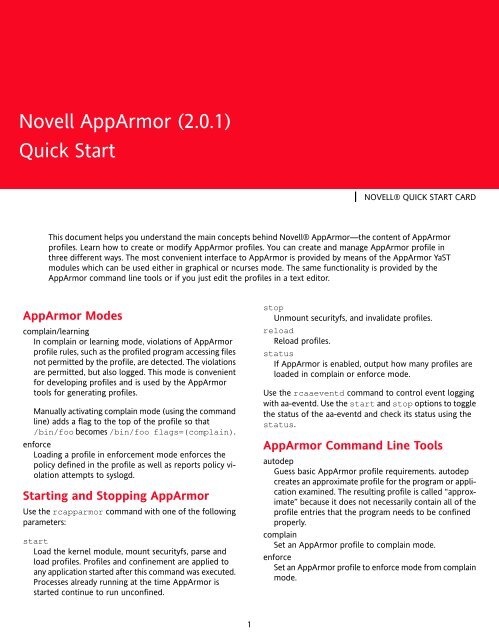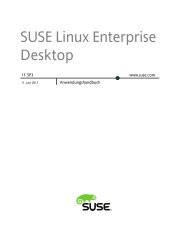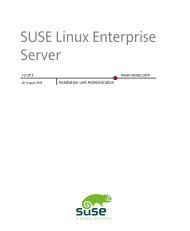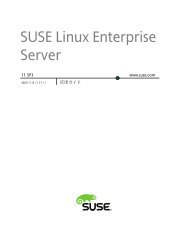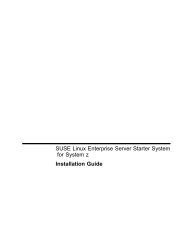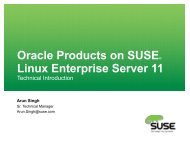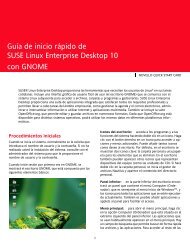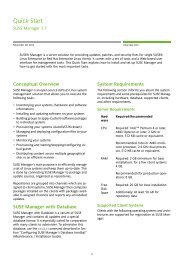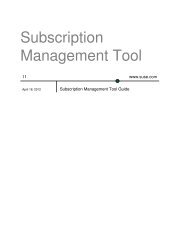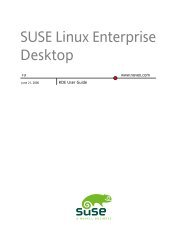Novell AppArmor (2.0.1) Quick Start - SuSE
Novell AppArmor (2.0.1) Quick Start - SuSE
Novell AppArmor (2.0.1) Quick Start - SuSE
Create successful ePaper yourself
Turn your PDF publications into a flip-book with our unique Google optimized e-Paper software.
<strong>Novell</strong> <strong>AppArmor</strong> (<strong>2.0.1</strong>)<br />
<strong>Quick</strong> <strong>Start</strong><br />
This document helps you understand the main concepts behind <strong>Novell</strong>® <strong>AppArmor</strong>—the content of <strong>AppArmor</strong><br />
profiles. Learn how to create or modify <strong>AppArmor</strong> profiles. You can create and manage <strong>AppArmor</strong> profile in<br />
three different ways. The most convenient interface to <strong>AppArmor</strong> is provided by means of the <strong>AppArmor</strong> YaST<br />
modules which can be used either in graphical or ncurses mode. The same functionality is provided by the<br />
<strong>AppArmor</strong> command line tools or if you just edit the profiles in a text editor.<br />
<strong>AppArmor</strong> Modes<br />
complain/learning<br />
In complain or learning mode, violations of <strong>AppArmor</strong><br />
profile rules, such as the profiled program accessing files<br />
not permitted by the profile, are detected. The violations<br />
are permitted, but also logged. This mode is convenient<br />
for developing profiles and is used by the <strong>AppArmor</strong><br />
tools for generating profiles.<br />
Manually activating complain mode (using the command<br />
line) adds a flag to the top of the profile so that<br />
/bin/foo becomes /bin/foo flags=(complain).<br />
enforce<br />
Loading a profile in enforcement mode enforces the<br />
policy defined in the profile as well as reports policy violation<br />
attempts to syslogd.<br />
<strong>Start</strong>ing and Stopping <strong>AppArmor</strong><br />
Use the rcapparmor command with one of the following<br />
parameters:<br />
start<br />
Load the kernel module, mount securityfs, parse and<br />
load profiles. Profiles and confinement are applied to<br />
any application started after this command was executed.<br />
Processes already running at the time <strong>AppArmor</strong> is<br />
started continue to run unconfined.<br />
1<br />
stop<br />
Unmount securityfs, and invalidate profiles.<br />
reload<br />
Reload profiles.<br />
NOVELL® QUICK START CARD<br />
status<br />
If <strong>AppArmor</strong> is enabled, output how many profiles are<br />
loaded in complain or enforce mode.<br />
Use the rcaaeventd command to control event logging<br />
with aa-eventd. Use the start and stop options to toggle<br />
the status of the aa-eventd and check its status using the<br />
status.<br />
<strong>AppArmor</strong> Command Line Tools<br />
autodep<br />
Guess basic <strong>AppArmor</strong> profile requirements. autodep<br />
creates an approximate profile for the program or application<br />
examined. The resulting profile is called “approximate”<br />
because it does not necessarily contain all of the<br />
profile entries that the program needs to be confined<br />
properly.<br />
complain<br />
Set an <strong>AppArmor</strong> profile to complain mode.<br />
enforce<br />
Set an <strong>AppArmor</strong> profile to enforce mode from complain<br />
mode.
genprof<br />
Generate a profile. When running, you must specify a<br />
program to profile. If the specified program is not an<br />
absolute path, genprof searches the $PATH variable. If<br />
a profile does not exist, genprof creates one using autodep.<br />
logprof<br />
Manage <strong>AppArmor</strong> profiles. logprof is an interactive tool<br />
used to review the learning or complain mode output<br />
found in the <strong>AppArmor</strong> syslog entries and to generate<br />
new entries in <strong>AppArmor</strong> profiles.<br />
unconfined<br />
Output a list of processes with tcp or udp ports that do<br />
not have <strong>AppArmor</strong> profiles loaded.<br />
Methods of Profiling<br />
Stand-Alone Profiling<br />
Using genprof. Suitable for profiling small applications.<br />
Systemic Profiling<br />
Suitable for profiling large numbers of programs all at<br />
once and for profiling applications that may run “forever.”<br />
To apply systemic profiling, proceed as follows:<br />
1. Create profiles for the individual programs that<br />
make up your application (autodep).<br />
2. Put relevant profiles into learning or complain mode.<br />
3. Exercise your application.<br />
4. Analyze the log (logprof).<br />
5. Repeat Steps 3-4.<br />
6. Edit the profiles.<br />
7. Return to enforce mode.<br />
8. Rescan all profiles (rcapparmor restart).<br />
Learning Mode<br />
When using genprof, logprof, or YaST in learning mode,<br />
you get several options for how to proceed:<br />
Allow<br />
Grant access.<br />
Deny<br />
Prevent access.<br />
Glob<br />
Modify the directory path to include all files in the suggested<br />
directory.<br />
Glob w/Ext<br />
Modify the original directory path while retaining the<br />
filename extension. This allows the program to access<br />
all files in the suggested directories that end with the<br />
specified extension.<br />
2<br />
Edit<br />
Enable editing of the highlighted line. The new (edited)<br />
line appears at the bottom of the list. This option is called<br />
New in the logprof and genprof command line tools.<br />
Abort<br />
Abort logprof or YaST, losing all rule changes entered<br />
so far and leaving all profiles unmodified.<br />
Finish<br />
Close logprof or YaST, saving all rule changes entered<br />
so far and modifying all profiles.<br />
Example Profile<br />
# a variable definition<br />
@{HOME} = /home/*/ /root/<br />
# a comment about foo.<br />
/usr/bin/foo {<br />
/bin/mount ux,<br />
/dev/{,u}random r,<br />
/etc/ld.so.cache r,<br />
/etc/foo.conf r,<br />
/etc/foo/* r,<br />
/lib/ld-*.so* mr,<br />
/lib/lib*.so* mr,<br />
/proc/[0-9]** r,<br />
/usr/lib/** mr,<br />
/tmp/foo.pid wr,<br />
/tmp/foo.* lrw,<br />
/@{HOME}/.foo_file rw,<br />
}<br />
# a comment about foo's subprofile, bar.<br />
^bar {<br />
/lib/ld-*.so* mr,<br />
/usr/bin/bar px,<br />
/var/spool/* rwl,<br />
}<br />
Structure of a Profile<br />
Profiles are simple text files in the /etc/apparmor.d directory.<br />
They consist of several parts: #include, capability<br />
entries, rules, and “hats.”<br />
#include<br />
This is the section of an <strong>AppArmor</strong> profile that refers to an<br />
include file, which mediates access permissions for programs.<br />
By using an include, you can give the program access<br />
to directory paths or files that are also required by other<br />
programs. Using includes can reduce the size of a profile.<br />
It is good practice to select includes when suggested.<br />
To assist you in profiling your applications, <strong>AppArmor</strong> provides<br />
three classes of #includes: abstractions, program<br />
chunks, and variables.
Abstractions are #includes that are grouped by common<br />
application tasks. These tasks include access to authentication<br />
mechanisms, access to name service routines, common<br />
graphics requirements, and system accounting, for example,<br />
base, consoles, kerberosclient, perl, user-mail, user-tmp,<br />
authentication, bash, nameservice.<br />
Program chunks are access controls for specific programs<br />
that a system administrator might want to control based<br />
on local site policy. Each chunk is used by a single program.<br />
Using variables, you can design your profiles to be portable<br />
to different environments. Changes in the variable's content<br />
are just made in the variable definition while the profile<br />
containing the variable can remain untouched.<br />
Capability Entries (POSIX.1e)<br />
Capabilities statements are simply the word “capability”<br />
followed by the name of the POSIX.1e capability as defined<br />
in the capabilities(7) man page.<br />
Rules: General Options for Files and<br />
Directories<br />
Option<br />
read<br />
write<br />
link<br />
File<br />
Rules: Defining Execute Permissions<br />
For executables that may be called from the confined programs,<br />
the profile creating tools ask you for an appropriate<br />
mode, which is also reflected directly in the profile itself:<br />
Option<br />
Inherit<br />
Profile<br />
Profile<br />
Unconstrained<br />
Unconstrained<br />
File<br />
ix<br />
px<br />
Px<br />
ux<br />
Ux<br />
r<br />
w<br />
Description<br />
l<br />
Stay in the same (parent's) profile.<br />
Requires that a separate profile exists<br />
for the executed program. No<br />
environment scrubbing.<br />
Requires that a separate profile exists<br />
for the executed program. Uses<br />
environment scrubbing.<br />
Executes the program without a<br />
profile. Avoid running programs in<br />
unconstrained or unconfined mode<br />
for security reasons. No environment<br />
scrubbing.<br />
Executes the program without a<br />
profile. Avoid running programs in<br />
unconstrained or unconfined mode<br />
for security reasons. This mode<br />
makes use of environment scrubbing.<br />
3<br />
Option<br />
Allow ExecutableMapping<br />
File<br />
m<br />
Description<br />
allow PROT_EXEC with mmap(2)<br />
calls<br />
WARNING: Running in ux Mode<br />
Avoid running programs in ux mode as much as<br />
possible. A program running in ux mode is not only<br />
totally unprotected by <strong>AppArmor</strong>, but child processes<br />
inherit certain environment variables from the<br />
parent that might influence the child's execution<br />
behavior and create possible security risks.<br />
For more information about the different file execute<br />
modes, refer to the apparmor.d(5) man page. For more<br />
information about setgid and setuid environment scrubbing,<br />
refer to the ld.so(8) man page.<br />
Rules: Paths and Globbing<br />
Glob<br />
*<br />
**<br />
?<br />
[ abc ]<br />
[ a-c ]<br />
{ ab,cd }<br />
Hats<br />
Description<br />
Substitutes for any number of characters,<br />
except /.<br />
Substitutes for any number of characters,<br />
including /.<br />
Substitutes for any single character, except<br />
/.<br />
Substitutes for the single character a, b,<br />
or c.<br />
Substitutes for the single character a, b,<br />
or c.<br />
Expand to one rule to match ab and another<br />
to match cd.<br />
An <strong>AppArmor</strong> profile represents a security policy for an<br />
individual program instance or process. It applies to an executable<br />
program, but if a portion of the program needs<br />
different access permissions than other portions, the program<br />
can “change hats” to use a different security context,<br />
distinctive from the access of the main program. This is<br />
known as a hat or subprofile.<br />
A profile can have an arbitrary number of subprofiles, but<br />
there are only two levels: a subprofile cannot have further<br />
sub-subprofiles.<br />
The <strong>AppArmor</strong> ChangeHat feature can be used by applications<br />
to access hats or subprofiles during execution. Currently<br />
the packages apache2-mod_apparmor and tomcat_apparmor<br />
utilize ChangeHat to provide sub-process<br />
confinement for the Apache Web server and the Tomcat<br />
servlet container.
Helpful Additions<br />
Autodocumentation<br />
The tool “sitar” gathers all system configuration information<br />
available from your system and creates comprehensive<br />
system documentation. It can be used to document all new<br />
and changed profiles.<br />
Logging and Auditing<br />
All <strong>AppArmor</strong> events are logged using the system's audit<br />
interface (the auditd logging to /var/log/audit/audit<br />
.log). On top of this infrastructure, event notification can<br />
be configured. Configure this feature using YaST. It is based<br />
on severity levels according to /etc/apparmor/<br />
severity.db. Notification frequency and type of notification<br />
(such as e-mail) can be configured.<br />
If auditd is not running, <strong>AppArmor</strong> logs to the system log<br />
located under /var/log/messages using the LOG_KERN<br />
facility.<br />
Use YaST for generating reports in CSV or HTML format.<br />
Directories and Files<br />
/sys/kernel/security/apparmor/profiles<br />
Virtualized file representing the currently loaded set of<br />
profiles.<br />
/etc/apparmor/<br />
Location of <strong>AppArmor</strong> configuration files.<br />
/etc/apparmor.d/<br />
Location of profiles, named with the convention of replacing<br />
the / in pathnames with . (not for the root /)<br />
so profiles are easier to manage. For example, the profile<br />
for the program /usr/sbin/ntpd is named usr.sbin<br />
.ntpd.<br />
/etc/apparmor.d/abstractions/<br />
Location of abstractions.<br />
/etc/apparmor.d/program-chunks/<br />
Location of program chunks.<br />
/proc/*/attr/current<br />
Review the confinement status of a process and the<br />
profile that is used to confine the process. The ps auxZ<br />
command retrieves this information automatically.<br />
For More Information<br />
To learn more about the <strong>AppArmor</strong> project, check out the<br />
project's home page under http://en.opensuse.org/<br />
<strong>AppArmor</strong>. Find more information on the concept and the<br />
configuration of <strong>AppArmor</strong> in the <strong>Novell</strong> <strong>AppArmor</strong> Administration<br />
Guide.<br />
Copyright © 2006 <strong>Novell</strong>, Inc. All rights reserved. No part of this publication may be reproduced, photocopied, stored on a retrieval system, or transmitted without the express<br />
written consent of the publisher. <strong>Novell</strong>, the <strong>Novell</strong> logo, the N logo, openSUSE, SUSE, and the "geeko" logo are trademarks of <strong>Novell</strong>, Inc. in the United States and other countries.<br />
All third-party trademarks are the property of their respective owners. A trademark symbol (®, TM, etc.) denotes a <strong>Novell</strong> trademark; an asterisk (*) denotes a third-party trademark.<br />
Created by SUSE® with XSL-FO<br />
4


